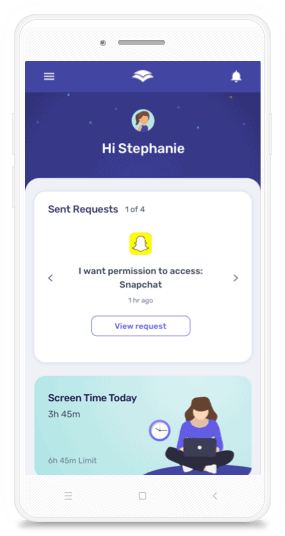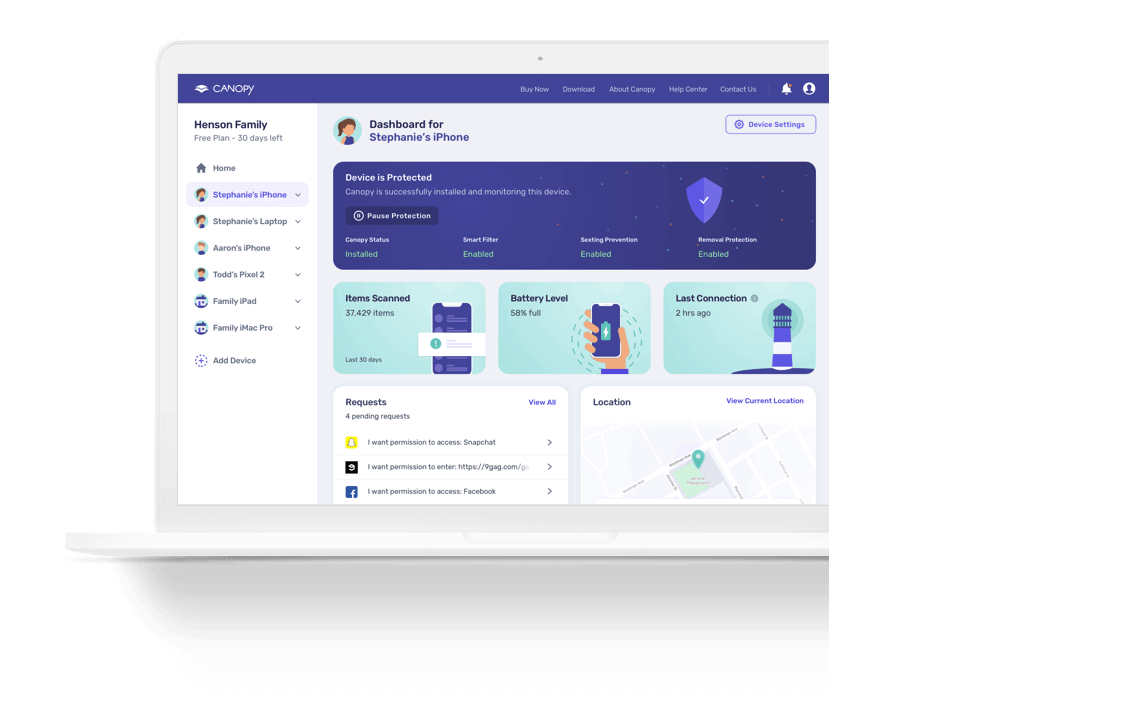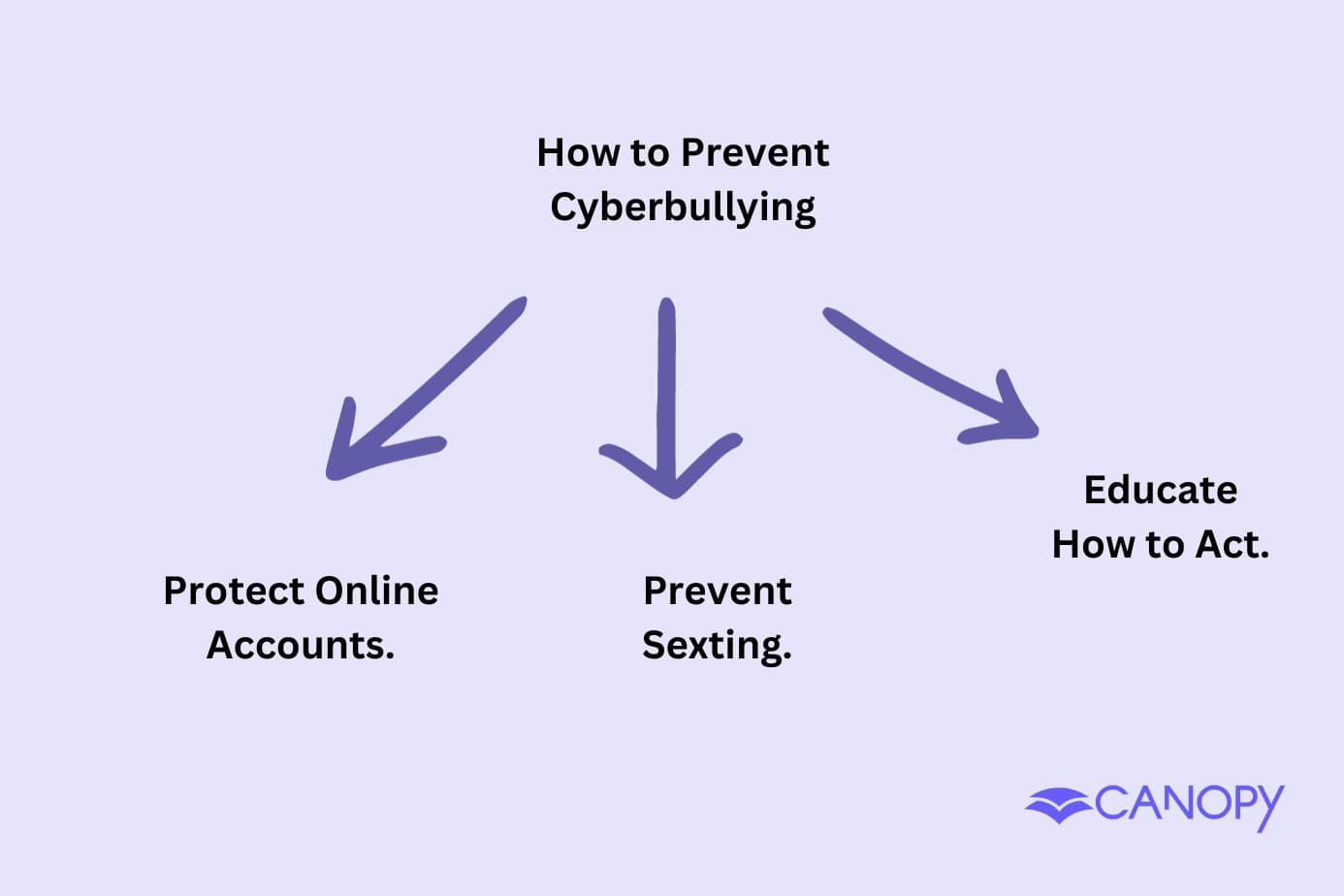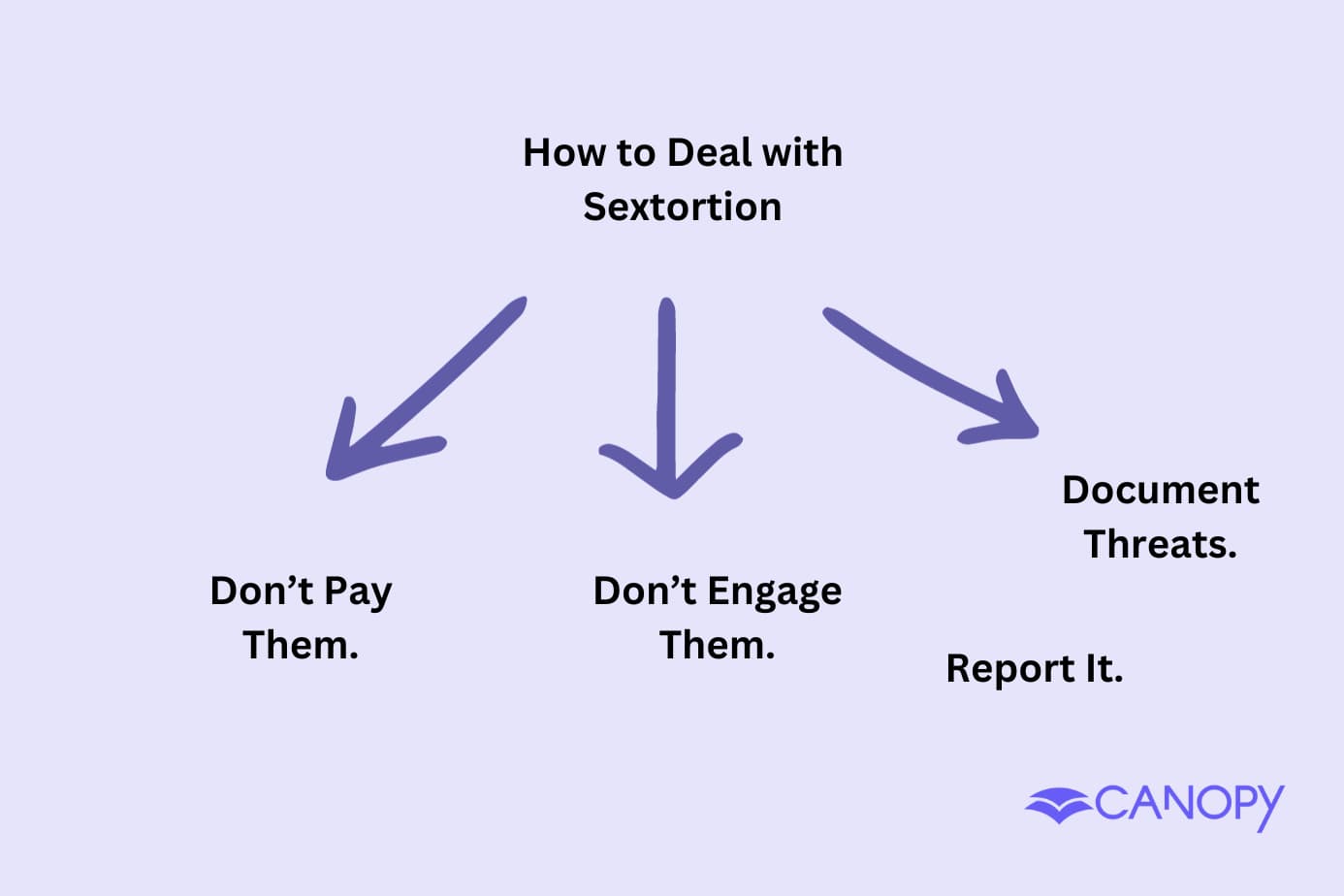You’re not alone in wanting to create a healthier online environment.
It’s exactly what I wanted when my children became old enough to access the computer on their own. And to be honest, there were sites I didn’t want to have access to either.
So I looked into how to block websites on a computer.
And here are the 5 I found that worked best:
- Overall best method: Canopy—a parental control app and porn blocker
- Method 2: macOS parental controls
- Method 3: Windows hosts
- Method 4: Third-party extensions
- Method 5: Router settings
Below you can see detailed step-by-step instructions for each method.
What Website Types are Worth Blocking?
There are roughly 1.13 billion websites on the internet. And a great many of them aren’t suitable for young eyes. Many others feed several unhealthy digital habits of adults.
What you block and why is up to you but here are some website types people often block:
- Pornography sites
- Gambling sites
- Sites that show violence
- YouTube and other social media sites
- Sites with access to mature games
- Drug-related sites
If you don’t want to take the time to block 1000s of sites, get Canopy to do it for you. Canopy filters out inappropriate content in real time, ensuring your browsing experience is a clean one.
Keep reading for step-by-step instructions that teach you how to block websites on laptop and desktop computers.
Best Method Overall: Use Canopy to Block Websites on Computer
Here’s the method, the benefits, and step-by-step for blocking specific websites from a computer using Canopy.
Method:
Canopy is a parental control app for children and porn blocker for adults. It blocks specific sites and apps while also filtering adult content in real-time.
You can watch the video below to learn more:
Canopy Parental Control App and Real-Time Smart Filter
Benefits:
Canopy works across all devices for comprehensive control over what you see and experience online. You’re able to block a site and, thanks to removal prevention, can trust that the settings won’t be undone unless you say so.
In addition to website and app blocking, Canopy also comes with screen time limits, location alerts, sexting prevention, and real-time content filtering.
Kara Goodie is a parent who uses Canopy to protect her children from inappropriate adult websites:
Why it’s number one:
Canopy’s protection covers multiple devices and accounts. So no matter where you’re browsing (PC, Mac, iPhone, iPad, Android, etc.) you and your family are protected.
If you have multiple children who need varying levels of parental control, you can adjust settings for each from the main account.
Check out the video below to hear why parents choose Canopy:
How to Block Websites on Computer Using Canopy
Here’s how I use Canopy to block websites on my computer.
1. Sign-up to Canopy: Register for a Canopy account and start a free trial.
2. Install the Canopy for Kids app: Download the app onto every device you’d like to protect. Here’s how you can do that.
3: Set up your chosen protection filters: Log into Canopy, click ‘Device Settings’ on the app or “Protection Settings’ on the web dashboard. Then select ‘Advanced Filtering.’
4: Block Websites: In the dashboard click ‘Websites’ and then ‘Add Website.’
5: Enter the URL you wish to block: Select the level of protection you would like. Then, hit save.
- ‘Filtered’ = Canopy will filter the app for inappropriate content
- ‘Unfiltered’ = Canopy will not filter any of the content within the app
- ‘Blocked’ – Canopy will prevent your child from accessing the app.
And that’s all it takes to block websites from your computer using Canopy.
→ Ready to get started with Canopy? Sign up to your free trial here. ←
Method 2: Use MacOS Screen Time Settings to Block Websites on Your Mac Computer
Here’s the method, the benefits, and step-by-steps for blocking any website from a Mac computer using Screen Time.
Method:
Screen Time on MacOS allows you to set limits on app usage, including blocking access to specific websites.
Benefits:
Using MacOS’s Screen Time to block a website ensures you can’t access the site, whether you’re using Safari, Chrome, or any available browser on the Mac.
It’s free to use and provides consistent protection..
Why it’s a good alternative:
While MacOS’s Screen Time doesn’t offer the real-time filtering capabilities of solutions like Canopy, it’s a pretty reliable method for Mac users. It’s also built-in to the system.
How to Block Websites from Mac Computer Using Screen Time
1. Open System Preferences: Click on the Apple logo in the top-left corner of your screen. Select ‘System Preferences.’
2. Access Screen Time: Within System Preferences, click on ‘Screen Time.’
3. Choose ‘Content & Privacy’: On the left sidebar, select ‘Content & Privacy.’ Make sure you have Content & Privacy Restrictions turned on. If you don’t, click ‘Turn on…’ in the upper right corner.
4. Click ‘Limit Adult Websites’: Under the ‘Web Content’ section, choose ‘Limit Adult Websites.’ Yes, even if the website isn’t technically an adult site.
5. Add the website URL to the list: Below the ‘Limit Adult Websites’ option, click the ‘Customize’ button and add the URL to the list of restricted sites.
6. Lock the settings: Click the ‘OK’ button at the bottom of the window.
And there you have it! You’ve blocked a website on your Mac, ensuring a safer browsing experience.
Combining this method with Canopy can provide robust online protection.
Method 3: Using Windows Hosts File to Block Websites on Your PC Computer
Here’s the method, the benefits, and step-by-step for blocking websites from a PC computer using Windows Hosts files. (Yes, this will block websites on Windows 10, too).
Method:
The Windows Hosts file maps hostnames to IP addresses. By adding a website, you can reroute any attempt to access it to a “dead end,” preventing the site from loading.
Benefits:
Modifying the Hosts file provides a system-wide block, making sure no browser on the PC can access the blocked site.
It also doesn’t rely on individual browser settings or third-party software.
Why it’s a good alternative:
While editing the Hosts file requires more technical know-how than other methods, it’s an effective way to block a website on Windows.
It’s useful for parents who want a solution that’s hard for tech-savvy kids to bypass.
However, for a user-friendly, comprehensive solution that offers real-time protection and is just as impossible for children to undo, Canopy remains a top choice.
How to Block Websites from PC Computer Using Windows Hosts File
1. Open Notepad as Administrator: Click on the Windows Start button, type “Notepad,” right-click on the Notepad app, and select “Run as administrator.”
2. Open the Hosts File: In Notepad, click on ‘File’ > ‘Open.’ Navigate to C:\Windows\System32\drivers\etc and select the ‘hosts’ file.
3. Add website entries: At the end of the file, add the following lines:
127.0.0.1 [insert URL without www.]
127.0.0.1 [insert URL with www.]
4. Save and close: Click ‘File’ > ‘Save’ to save your changes and then close Notepad.
5. Restart your computer: For the changes to take effect, restart your PC.
With these steps, any website you wish is now blocked on your PC. It’s a technical yet effective method.
Method 4: Using Browser Extensions to Block Websites (Chrome for Windows or Mac)
Here’s the method, its benefits, and step-by-step instructions for blocking a website on your computer when using Chrome.
Method:
Chrome extensions are software that can be added to your browser. There are ones that block websites.
One example is Block Site.
Benefits:
Chrome extensions are easy to install and integrate into your browser. You can even find free versions.
Why it’s a good choice:
If you use Chrome on your computer (Windows or Mac), a Chrome extension is easy to install and manage.
Where it falls short:
These extensions only work for the browser they’re installed on. So if you occasionally use another browser, you’ll need multiple solutions.
That’s why I prefer Canopy. Canopy offers thorough content filtering and blocking across all devices and browsers.
Step by Step: How to Block Websites Using a Browser Extension (Block Site)
1. Open Chrome and go to the Chrome Web Store: Just search “Chrome Web Store” on Google and click on the first result.
2. Search for the Block Site Extension: In the search box on the top left of the screen, type in “Block Site” and press enter. Click on the first result, which should be the “Block Site – Website Blocker for Chrome™”.
3. Add the extension to Chrome: Click on the “Add to Chrome” button next to the extension name. In the confirmation box that appears, click “Add extension”.
4. Access the extension settings: Once installed, you will see the Block Site extension icon at the top right corner of your browser. Click on it and then click on the gear icon to open the settings.
5. Enter the URL of the website you want to block: In the “Block Sites” section, type in the URL and click on the “+ Add page” button. The website will be added to your block list.
6. Apply the changes: Click on the “Apply” button at the bottom of the screen to save your settings.
Method 5: Using Home Router Settings when Blocking Websites on Computer
Method:
Most modern routers come with built-in parental controls or website filtering options.
By accessing these controls, you can set up a rule to block the website, ensuring that no device connected to your home Wi-Fi can access it.
Benefits:
Blocking websites at the router level is a comprehensive approach. It ensures that the website is inaccessible across all devices, be it PCs, smartphones, tablets, or even smart TVs.
Why it’s a good option but not the best:
Yes, this method works across all computers but it can be bypassed by turning off the wifi and ‘hotspotting’ the computer from a mobile phone network.
It’s also quite technical to set up for those of us who prefer simple solutions like the one Canopy offers.
How to Block Websites from Computer Using Your Home Router
1. Access your router’s settings: Open a web browser and enter your router’s IP address (commonly “192.168.1.1” or “192.168.0.1”). You may need to consult your router’s manual for the specific address.
2. Login: Enter the username and password for your router. If you haven’t changed these, they might be set to the default (check your router’s manual or sticker).
3. Navigate to ‘Parental Controls’ or ‘Website Filtering’: The exact name might vary based on the router brand. Look for sections like “Parental Controls,” “Access Restrictions,” or “Website Filtering.”
4. Add the URL to the block list: There should be an option to block specific websites. Add the URL and any related domains to the list.
5. Save and apply: Confirm your settings and save. The router might need a restart for the changes to take effect.
Common questions I get about blocking websites on a computer
Below I’ve answered the most common questions that come with the topic of blocking websites on computers (either for yourself or for your family).
Can I block specific content instead of entire websites?
Yes, you can use parental control apps to block categories of websites and even filter out nudity in search results, on ads, and on sites. Blocking categories can often be more effective than blocking singular websites. But I recommend combining both features for comprehensive coverage.
Canopy does that for you.
How do I block websites on my child’s computer?
The article outlines several methods for blocking websites on a computer. If you’re worried about your child’s access to specific websites and content, consider Canopy—a parental control app that can block and filter websites and apps across devices.
That means you won’t have to worry when your child is on their computer, their tablet, or their phone.
Related Website Blocking Guides
Check out other guides in our complete internet safety series:
- How to Block Websites on a Router
- How to Block Websites on Your Phone (Permanently!)
- How to Block Websites on Safari Browser
- How to Block Websites on iPad
- How to Block Adult Websites on iPhone
- How to Block Specific Websites Only
- How to Block Websites on Chrome Mobile
- How to Block YouTube Content
- 15 Best Parental Control Apps
- 7 Best Porn Blockers





